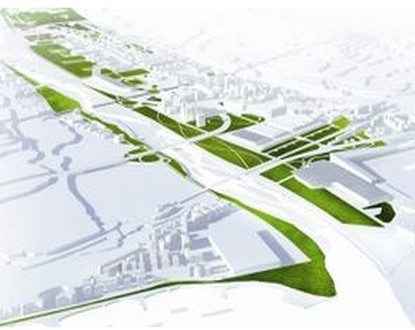Annabelle Jaeger (Regional Councilor EELV – delegate for biodiversity):
“Let’s stop playing sorcerer’s apprentice with the Var and the inhabitants of its banks!”
The EPA should consider a territory project that respects the Var River… and the inhabitants of the Plain.
If minds are not yet ready for such a questioning of decades of development, the costs of which we are paying today, are they ready to not worsen the situation??
Once again, EELV calls for genuine democratic consultation, the only way to mitigate the majority of the significant risks inherent in the Plaine du Var operation.
– The Flood Risk Prevention Plan (PPRI) Low Var Valley: short-term solutions, ineffective and costly for taxpayers
The weekend’s events demonstrate the limits of the current management of the River:
– the dikes struggle to contain a flow of “only” 1000 m3, and the flooding of Cap 3000, the roads along the Var at its mouth prove that the current management of the River quickly reaches its limits;
– the Puget Théniers dike showed signs of fragility, proving, if it were necessary, that they are not invincible;
– information on risks for the population was lacking, even though knowledge of risks and the transmission of information is at the heart of responsible planning policy around a river.
The dikes give citizens the illusion that new spaces are protected and therefore freed to meet their needs: they are promised developments that create jobs during a crisis, or long-awaited housing… but the day these facilities are swept away by a flood, it is the whole society that will have to pay to repair the damage, it is our insurance and our communities that will pay for this risk-taking.
Instead of channeling and developing in the riverbed by increasing impermeable surfaces, it is about giving the river its place and making development choices compatible with flood risks.
The PPRI has enacted short-term solutions for the sole purpose of recovering fertile land to build and start the developments of the OIN. The planned dikes are not meant to contain a torrential river like the Var.
In the long term, it is simply not effective. A wider major bed must be preserved so that water can spread out in the event of a flood. The cost of this supposed domestication for taxpayers is financially enormous.
EELV is ringing the alarm bell by telling the management of the Public Development Establishment that it is still time to reflect on the OIN Plaine du Var territory project to take into account all these risks for sustainable territorial development.
And isn’t it time to take a more serious look at the proposals made by the West 8 team to the EPA aimed at returning space to the Var River?
West 8, a Dutch urban planning agency, worked in 2011 for the EPA as part of the Definition Studies.
Its conclusions, presented last September 26 during the opening of the “Consultation” OIN Plaine du Var, aim to develop the Plain by understanding the risk of floods from the River, by giving it space through additional spaces for mobility in case of major floods. The improvement of the delta is planned by widening the river’s mouth; bold proposals go as far as demolishing or moving 2 major infrastructures that obstruct its natural flow: Cap 3000 and the Airport – which, according to West 8, could be rebuilt at sea using a floating structure.
Bold but credible coming from a Dutch team used to planning developments that coexist with water.


